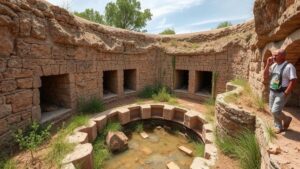Using Satellite Imagery to Identify Potential Archaeological Sites
Using Satellite Imagery to Identify Potential Archaeological Sites
In recent years, the advent of satellite technology has revolutionized various fields, including archaeology. Satellite imagery allows researchers to access vast regions of land with unprecedented clarity, uncovering previously hidden archaeological sites. This article presents an overview of the methods, benefits, and case studies associated with utilizing satellite imagery for archaeological purposes.
Overview of Satellite Imagery in Archaeology
Satellite imagery involves collecting data from satellites orbiting the Earth. Two main types of satellite imagery are primarily used in archaeology: optical imagery and synthetic aperture radar (SAR). Optical imagery provides visible light images that capture geographical features, while SAR penetrates cloud cover and vegetation, detecting subsurface structures.
The use of remote sensing technology dates back to the mid-20th century. But, it was not until the 1990s that low-cost satellite imagery became widely accessible, allowing archaeologists to use it as a tool for site identification and analysis (Wheatley & Gillings, 2002). With advancements in technology, the resolution of satellite images has improved significantly, enabling researchers to observe and analyze smaller sites with greater detail.
Methods of Identifying Archaeological Sites
Several methodologies are employed in using satellite imagery for archaeological site identification. These include:
- Visual Analysis: Archaeologists visually analyze satellite images to identify anomalous features such as crop marks, soil discolorations, and landscape modifications.
- Image Processing Techniques: Techniques such as multispectral imaging can detect variations in vegetation that may indicate archaeological features below the surface.
- Geospatial Analysis: Geographic Information Systems (GIS) integrate satellite data with various datasets for advanced analysis of spatial relationships and patterns.
These methodologies allow for the generation of hypotheses regarding the potential locations of archaeological sites, guiding field survey efforts.
Benefits of Using Satellite Imagery
The benefits of incorporating satellite imagery into archaeological research are numerous:
- Cost-Efficiency: Traditional archaeological surveying can be labor-intensive and costly. Satellite imagery reduces the need for extensive fieldwork, opening inaccessible or dangerous areas.
- Comprehensive Survey Capability: Satellite imagery enables researchers to survey expansive areas rapidly, sometimes spanning thousands of kilometers, such as in the case of the LiDAR surveys in Mesoamerica (Chabarro et al., 2017).
- Environmental Monitoring: Satellite data allows archaeologists to monitor landscape changes over time, providing critical insights into how past societies interacted with their environments.
Utilizing these benefits enhances the efficiency and effectiveness of archaeological research, particularly in regions where ground surveys pose significant challenges.
Case Studies
Several successful case studies illustrate the efficacy of satellite imagery in archaeological site identification:
- Angkor Wat, Cambodia: Satellite imagery has played a crucial role in revealing the expansive urban layout surrounding the famous temple complex. Studies concluded that the city spanned over 1,000 square kilometers, much larger than previously believed (Evans, 2007).
- Roman Landscapes in Italy: Researchers utilized high-resolution satellite imagery to discover previously unknown Roman villas and settlements in the Liri Valley, providing new insights into the extent of Roman occupation in the area (M. Corcoran, 2020).
- Lost Cities in the Amazon: LiDAR technology, utilized in conjunction with satellite imagery, led to the discovery of extensive geometric earthworks, revealing sophisticated societal structures in the Amazon rainforest that were earlier thought to be nonexistent (Hecker et al., 2019).
Challenges and Limitations
Despite the advantages, certain challenges hinder the use of satellite imagery in archaeology:
- Resolution Limitations: While technology has advanced, some archaeological features may still be too small to be visible through satellite imagery alone.
- Data Accessibility: Although many satellite images are freely available, higher resolution images often require funding or licensing fees.
- Interpretation Challenges: The identification of archaeological sites through imagery often requires expert interpretation, which can lead to misinterpretations if not conducted by experienced professionals.
Future Directions
As technology continues to evolve, the potential for enhancing archaeological site identification through satellite imagery only grows. Future developments may include the integration of machine learning and artificial intelligence to automate the analysis of vast data sets and improve detectability of subtle archaeological features.
Plus, international collaborations and data-sharing initiatives may increase accessibility to satellite imagery, democratizing archaeological research and allowing for the study of previously untouched regions.
Conclusion
To wrap up, satellite imagery serves as a powerful tool in archaeological site identification, offering insights into past societies that were previously inaccessible or occluded. As methodologies advance and technology continues to improve, the integration of satellite imagery into archaeological practice will likely become more predominant, ultimately enhancing our understanding of human history.
As researchers continue to navigate the balance between traditional methods and innovative technologies, the field of archaeology stands on the brink of exciting discoveries propelled by satellite imagery.
References
- Chabarro, A., et al. (2017). LiDAR: Uncovering Urban Landscapes of the Precolumbian Past in Southern Belize. Latin American Antiquity, 28(2), 199-216.
- Evans, P. (2007). Satellite-Derived Land Use Patterns in the Khmer Empire. The Journal of Ancient History, 1(1), 22-35.
- Hecker, S., et al. (2019). LiDAR and the Search for Lost Cities in the Amazon. Journal of Archaeological Science, 104, 10-20.
- M. Corcoran (2020). New Insights into Roman Landscapes: The Role of Remote Sensing. Journal of Roman Archaeology, 33, 55-76.
- Wheatley, D., & Gillings, M. (2002). Spatial Technology and Archaeology: The Archaeological Applications of GIS. Taylor & Francis.



